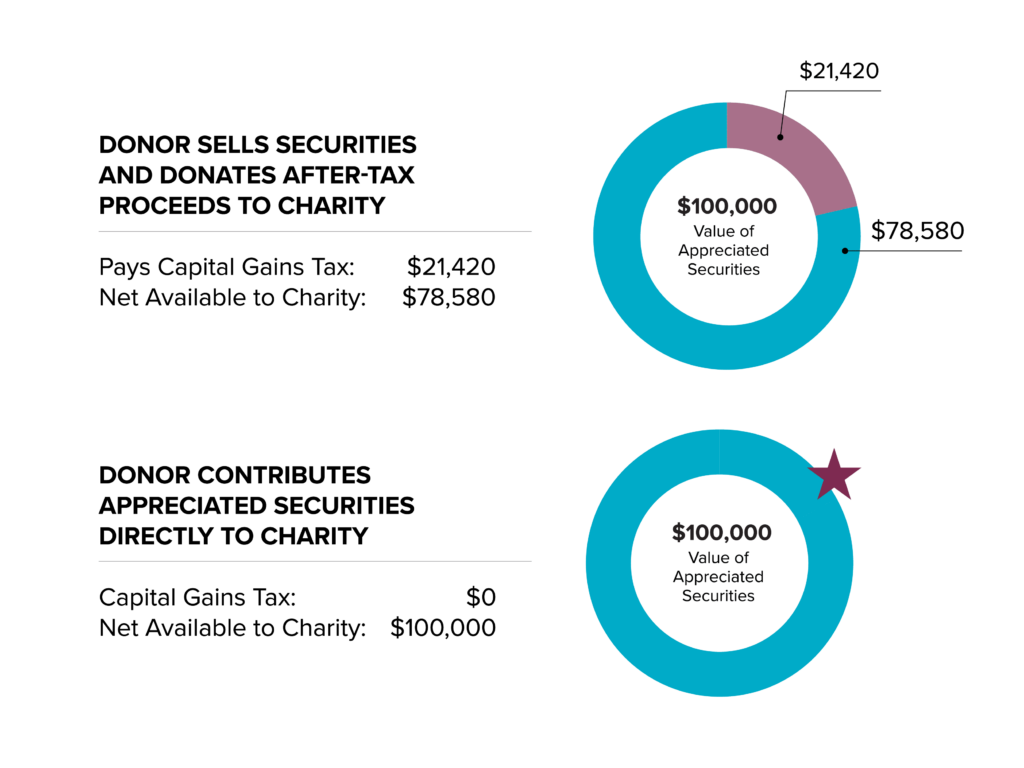Learn About DAFs
Giving with a donor-advised fund has become a popular tax-efficient way to conduct philanthropy amongst charitable donors and families.
Donor-advised funds (DAFs) are giving accounts established at a public, section 501(c)(3) nonprofit charity that enable donors to make charitable contributions and claim immediate tax benefits. Donating through a DAF offers a wide range of unique tax benefits compared to other tax vehicles. These benefits include:
- Receive immediate tax deductions following a contribution.
- Claim income tax deductions on the fair-market value of an asset.
- Avoid capital gains tax on contributed long-term appreciated assets.
- Grow the amount you contribute over time tax-free.
These benefits are one of the many reasons why grantmaking through DAFs has rapidly increased in recent years, and even totaled $45.74 billion in FY 2022.
Learn more about the tax benefits of donor-advised funds below and reduce your tax liability while increasing your charitable impact.
Donor-Advised Fund Tax Benefits and Strategies
1. Grow Your Charitable Dollars Tax-Free.
The charitable dollars in your DAF can be invested before they are granted out. With market growth, your DAF balance can also grow. This makes even more money available for grantmaking. Moreover, while you can take an immediate tax deduction for the gifts you make to your DAF, you will not be taxed on any growth, since the assets belong to the DAF’s charitable sponsor.
2. Manage the Timing of Your Charitable Deduction.
Because a contribution to a donor-advised fund (DAF) is a gift to a public charity, donors who contribute to their DAFs are eligible to take a tax deduction in that calendar year. Donating cash by check or wire transfer generally means that the donor will be eligible to deduct up to 60% of their adjusted gross income (AGI), with a five-year carry-forward for unused deductions. By controlling the timing of the DAF contribution, donors can manage the timing their own tax deductions while planning for future grantmaking to qualified charities.
3. Reduce Tax Burden in a Windfall Year.
DAFs can reduce tax burdens after a windfall situation, such as receiving an inheritance, selling a business, or experiencing strong market returns. You can take an immediate tax deduction when you make a charitable contribution to your DAF, reducing your tax liability. DAFs allow you to recommend grants to your favorite charities over time, so you can effectively pre-fund years of giving with assets from a single high-income event.
4. Contribute Appreciated Assets to Reduce or Eliminate Capital Gains.
Direct donation of publicly traded securities (or other non-cash assets) is one of the most common ways to fund a DAF. This is a particularly tax-efficient method because securities that have been held for more than one year can be donated at their fair market value, and are not subject to capital gains tax. If a donor were to liquidate their assets and later donate the proceeds to their DAF, the amount would be reduced by capital gains tax, leaving less money available for philanthropy. Donors receive an immediate tax deduction of up to 30% of adjusted gross income (AGI) for gifts of appreciated securities, mutual funds, real estate and other assets, and can enjoy five-year carry-forward deduction on gifts that exceed AGI limits.
Donating Appreciated Stock: A Case Study
By donating appreciated stock held for more than one year directly to a DAF—rather than liquidating it and then donating the proceeds—philanthropists can reduce their tax liability by eliminating capital gains tax, as well as reducing their marginal income tax.
In the hypothetical example below, a donor has $100,000 in long-term appreciated stock, and its original cost-basis purchase price was $10,000:

Using a DAF, this donor would have more available to give to charity and would pay less in taxes. This strategy can often allow donors to give more than 20% more to the causes they care about.
Note: For the purposes of illustration, this hypothetical example assumes a 35% income tax rate. It also assumes that all realized gains are subject to the federal long-term capital gains rate of 20% and the Medicare surtax of 3.8%. No other state taxes are taken into account.
Learn More about DAFs
- NPT’s Uniquely Flexible DAF
- Benefits of Donor-Advised Funds
- Contribution Guide
- Grantmaking Guide
- Open a DAF Account
The information provided here is general and educational in nature. It is not intended to be, nor should it be construed as, legal or tax advice. NPT does not provide legal or tax advice. Furthermore, the content provided here is related to taxation at the federal level only. NPT strongly encourages you to consult with your tax advisor or attorney before making charitable contributions.
Find Out More
Learn about how a DAF works
—and how it can work for you. Read some of our most frequently asked questions about donor-advised funds, the fastest-growing charitable giving vehicle. You'll learn about the account opening process, the types of assets you can contribute, the tax advantages, and how to get started.
FAQs
